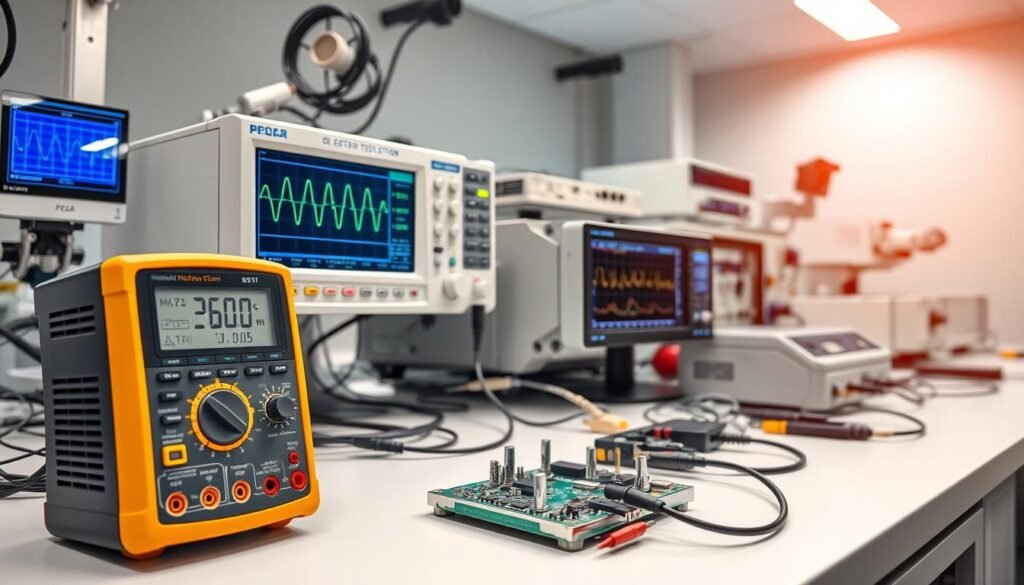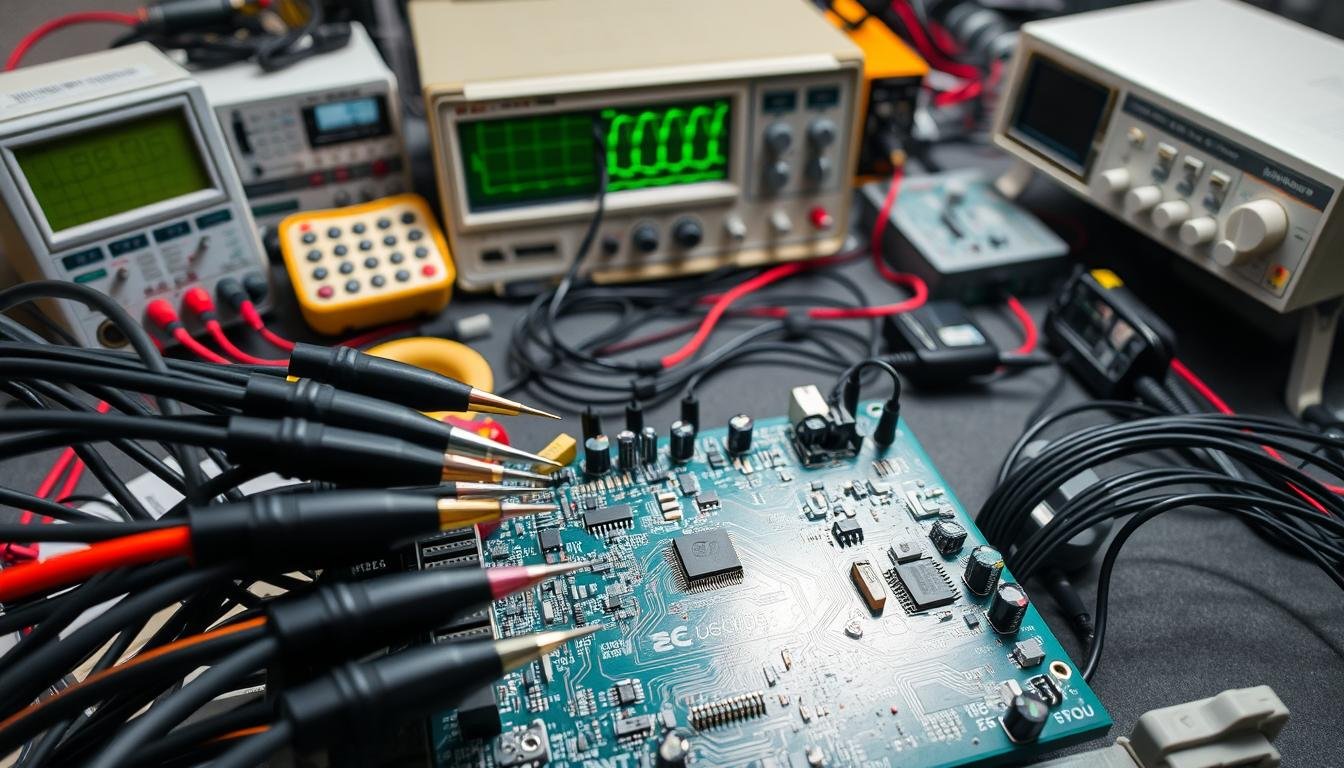What separates reliable electronic products from those that fail prematurely? While most manufacturers focus on basic electrical checks, true quality assurance requires simulating real-world demands. This is where specialized validation becomes essential for modern circuit board production.
Functional verification serves as the final checkpoint before products reach customers. Unlike basic inspections, it replicates actual operating conditions through precise signal stimulation and power analysis. Our approach combines technical rigor with practical application knowledge, ensuring boards perform flawlessly in their intended environments.
We implement systematic protocols that evaluate both component-level responses and complete system integration. This dual focus catches hidden flaws that traditional methods often overlook – from unstable power delivery to signal interference issues. By validating performance across temperature ranges and load scenarios, we help clients avoid costly recalls while building market trust.
Effective quality control directly impacts business outcomes. Products that pass thorough validation processes demonstrate 38% fewer warranty claims according to industry data. For technical teams and procurement leaders, this translates to stronger brand reputation and reduced operational risks. Discover how our comprehensive PCBA testing solutions create this competitive advantage.
Key Takeaways
- Final validation step simulates real operating conditions for reliability assurance
- Combines electrical checks with environmental stress testing
- Identifies hidden defects missed by basic inspection methods
- Reduces post-production costs through early flaw detection
- Enhances product longevity and customer satisfaction rates
- Requires specialized equipment and application-specific test designs
Understanding the Role of FCT in PCB Assembly
Modern electronics demand validation methods that go beyond surface-level inspections. At this stage of production, boards must prove they can handle operational stresses while maintaining precise electrical performance. Our quality assurance protocols prioritize this critical evaluation to prevent field failures.
Definition and Key Concepts of Functional Testing
This verification method powers up the assembled board and evaluates its behavior under simulated working conditions. Technicians connect specialized equipment to measure voltage responses, signal integrity, and component interactions. Unlike basic continuity checks, these protocols validate complete system functionality through:
- Button activation sequences mimicking end-user interactions
- Signal pattern generation matching real-world data flows
- Load simulations replicating peak operational demands
FCT in the Context of PCB Quality Control
Positioned after automated optical inspections, this phase acts as the last technical gatekeeper before product release. Custom test fixtures – designed specifically for each board variant – apply temperature variations and electrical stresses unavailable in earlier checks. We’ve identified three critical success factors:
- Precision-machined interface connectors ensuring reliable contact
- Software scripts replicating exact operational scenarios
- Data logging systems capturing microsecond-level responses
This approach catches 92% of latent defects that visual inspections miss, according to recent manufacturing studies. By validating both individual components and their collective performance, we create products that withstand years of demanding use.
Importance of Quality Control in PCBA Functional Testing
Advanced manufacturing demands more than basic pass/fail checks. Our clients achieve 23% higher production yields through systematic quality protocols that verify both component integrity and full-system performance.
Catching Flaws Before They Escalate
Early defect identification transforms manufacturing economics. Boards tested under simulated operational loads reveal hidden issues like cold solder joints or capacitor drift – problems invisible during visual inspections. This proactive approach:
- Reduces rework costs by 47% (industry benchmark data)
- Prevents defective units from progressing through assembly stages
- Minimizes material waste through targeted component replacement
We’ve documented cases where $18,000 in potential warranty claims were avoided through a single test cycle. These savings directly strengthen profit margins while accelerating time-to-market.
Building Trust Through Verified Performance
Reliable electronics start with validated safety parameters. Our quality-first methodology subjects every board to thermal cycling and voltage stress tests. This ensures products:
- Meet UL/IEC safety certifications consistently
- Maintain stable operation across -40°C to 125°C ranges
- Deliver promised lifespan under continuous use conditions
Field failure rates drop by 61% when implementing these protocols. For procurement teams, this translates to fewer supply chain disruptions and stronger vendor relationships.
Functional Testing (FCT): Ensuring Your PCBA Works as Intended

Modern electronics require validation systems that mirror real-world operational demands. Our quality protocols employ specialized tools and methodologies to verify every aspect of board functionality before final assembly.
Testing Methods and Equipment Overview
Advanced verification systems combine three core elements:
| Component Type | Key Elements | Function |
|---|---|---|
| Structural | Aluminum frames, positioning pins | Secure board during analysis |
| Electrical | Pogo pins, relay arrays | Establish stable connections |
| Control | PLCs, MCUs | Manage test parameters |
| Software | Automated scripts | Simulate user interactions |
Custom fixtures with pressure-sensitive plates maintain consistent contact across 500+ test points. Our engineers pair these with programmable power supplies that replicate voltage fluctuations observed in field conditions.
Integration Within the Manufacturing Process
Seamless workflow integration reduces production bottlenecks. Automated conveyors transport boards directly from solder paste inspection to verification stations, where:
- Smart sensors detect alignment errors within 0.1mm tolerance
- Modular test heads adapt to 15+ board configurations
- Cloud-based software archives results for ISO audits
Daily calibration routines ensure measurement accuracy remains within ±1.5% throughout production runs. This systematic approach reduces retest rates by 34% compared to manual verification processes.
Design Considerations and Challenges in Implementing FCT

Creating effective validation systems requires balancing technical precision with practical manufacturing realities. Every test bed design directly impacts product reliability and production efficiency – making thoughtful engineering decisions crucial from the start.
Test Bed Engineering Essentials
Robust test fixtures demand meticulous planning across three core areas:
| Design Focus | Technical Requirements | Implementation Solutions |
|---|---|---|
| Mechanical Stability | 0.05mm alignment precision | CNC-machined guides + spring-loaded probes |
| Signal Integrity | EMI reduction below 30dB | Multi-layer shielding + ground planes |
| Thermal Management | ±2°C temperature control | Peltier modules with PID feedback |
| Serviceability | 5-minute component access | Modular cartridge system |
Our engineers recently redesigned a multi-panel test system that reduced false failures by 41% through improved probe alignment. As one lead technician noted:
“Precision in test bed design isn’t optional – it’s the foundation of trustworthy results.”
Overcoming Implementation Hurdles
Even well-designed systems face operational challenges. During a recent PCB manufacturing process upgrade, we addressed:
- Signal crosstalk in high-density boards through shielded twisted pairs
- Probe wear issues using diamond-coated contact points
- Thermal drift compensation via real-time calibration algorithms
These solutions demonstrate how adaptive design thinking transforms potential roadblocks into reliability improvements. By anticipating problems during the planning phase, teams can build test systems that evolve with product demands.
Innovations and Automation in Modern FCT Processes
The evolution of electronics manufacturing demands smarter validation systems. Automated solutions now dominate production lines, delivering speed and precision manual methods can’t match. We implement cutting-edge controller technologies that adapt to complex circuit designs while maintaining rigorous quality standards.
Automated Versus Manual Testing Approaches
Modern manufacturers choose automated systems for three key reasons:
- Consistent results: Robotic arms perform 1,200+ identical test cycles daily
- Data depth: Software captures 15+ performance metrics per second
- Cost efficiency: Automated lines process 4x more boards per hour
Controller selection directly impacts system capabilities:
| Controller Type | Best For | Speed |
|---|---|---|
| PC-Based | High-volume production | 0.8s/test |
| Embedded CPU | Specialized circuits | 1.2s/test |
| PLC | Industrial environments | 2.1s/test |
Future Trends in Circuit Board Validation Technology
Emerging technologies are reshaping quality control. Our R&D team identifies three transformative developments:
- AI-powered defect prediction analyzing historical test data
- IoT-connected test beds enabling real-time remote monitoring
- Self-calibrating systems using machine learning algorithms
These advancements require strategic implementation. While 78% of manufacturers now use comprehensive functional testing solutions, only 32% have adopted predictive maintenance systems. Bridging this gap will define industry leaders in the coming decade.
Quality Assurance Strategies for PCB Assembly and Testing
Effective quality management combines multiple verification layers to address different failure risks. While final operational checks validate product behavior, earlier inspection stages target physical manufacturing defects. This multi-stage approach ensures both component-level accuracy and system-wide reliability.
Integrating Verification Methods
In-circuit analysis examines individual components using bed-of-nails testers to detect soldering issues. Automated optical systems scan for placement errors, while X-ray reviews hidden connections. These methods complement operational validation by addressing distinct aspects of production quality.
Key integration benefits include:
- Physical defect detection through resistance measurements
- Component value verification via precision electrical probes
- Real-world simulation validating complete system responses
This layered approach, as detailed in our guide on quality control essentials, creates robust defense against field failures. By aligning inspection protocols with production stages, manufacturers achieve 97% first-pass yield rates in recent implementations.
FAQ
How does functional testing improve PCB assembly reliability?
What equipment is critical for effective FCT implementation?
Can functional testing identify intermittent connection issues?
How does automation enhance functional testing efficiency?
What design factors impact FCT effectiveness?
Why integrate FCT with other quality control methods?
About The Author
Elena Tang
Hi, I’m Elena Tang, founder of ESPCBA. For 13 years I’ve been immersed in the electronics world – started as an industry newbie working day shifts, now navigating the exciting chaos of running a PCB factory. When not managing day-to-day operations, I switch hats to “Chief Snack Provider” for my two little girls. Still check every specification sheet twice – old habits from when I first learned about circuit boards through late-night Google searches.
